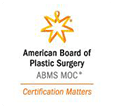Having performed transgender and non-binary surgery since 2014, our practice has refined a successful and safe method for vaginoplasty genital reconstruction surgery (GRS). We use the tried and proven inverted penile skin and scrotal skin graft (penile inversion) method for full- or moderate-depth vaginoplasty.

Two methods of vaginoplasty surgery
Vaginoplasty GRS for trans female and non-binary patients is performed in two ways: penile inversions and peritoneal pull-through. In both procedures, the penile shaft skin becomes the labia minora, majora and clitoral hood, while the top skin on the head of the penis becomes the clitoris. The difference is the internal lining of the vaginal tract.
For the penile inversion, the vaginal tract is composed of the distal end of the penis and thinned scrotal skin. If patients do not have enough scrotal skin, we use tunica vaginalis from around the testes or man-made thin biologic grafts to create the vaginal lining. This surgical method creates excellent results for function and aesthetics.
For the peritoneal pull-through method, lining from the abdomen is used to create the vaginal tract lining. The surgeon enters the abdomen with laparoscopic instruments and peels some of the peritoneal lining off the inside wall of the abdominal cavity. If possible, the peritoneal graft is kept attached on a small pedicle and the rest is stretched downward for lining the vaginal tract. The space between the rectum and the bladder is dissected to connect the peritoneum to the other vaginal graft lining. The peritoneum is sutured to the end of the penile shaft or scrotum if it is utilized.
Downsides of peritoneal pull-through surgery
Our surgeon, Dr. Keelee MacPhee, strongly prefers the penile inversion over the peritoneal pull-through method, because the latter introduces unnecessary risks that can easily be avoided by using the skin and readily available grafts. The peritoneal approach involves invasive intra-abdominal surgery. Any surgery that enters into the abdominal cavity puts the patient at risk of long-term complications such as adhesions that block the intestines, hernia development and internal scarring and pain.
Furthermore, while the peritoneum and intestines have been portrayed as good choices for creating a self-lubricating lining, research has shown otherwise. Even proponents of the peritoneal pull-through procedure admit they have not had success in creating self-lubricating vaginal tracts. According to Mount Sinai regarding peritoneal pull-through:
“Creating a self-lubricating vagina has been a challenge. Our surgeons have pioneered an approach using the peritoneal lining. The peritoneal lining is hairless and pink. While the peritoneal vaginoplasty does provide moisture, it is not self-lubricating. Patients will still need to use water-based lubricant for intercourse and dilation.”
Advantages of inverted penile skin and scrotal skin graft
With penile inversion GRS, patients avoid the risk of potential intra-abdominal infections or blocked intestines, have less scarring and can return to regular foods right after surgery. Moreover, they have a better functional outcome.
After surgery, the scrotal skin transitions from normal-looking skin to a pink, moist vaginal lining as patients go through their vaginal dilation and douching process. We have performed many intra-vaginal speculum exams post-operatively to confirm there are no more than a few hairs growing in the first few months. With those exams, we find a pink, shiny lining from the transformed skin graft.
Another advantage of the scrotal skin graft is that pre-operative hair removal is not necessary. Our procedure removes the layer of skin that contains the hair follicles and drastically reduces the dormant hair follicles that are not visible at the time of surgery. After we remove the scrotal skin, it is thinned, and most of the hair follicles are scraped away. Dr, MacPhee then follows with a needle-tip cautery to zap and destroy all visible hair follicles.
We have found that most patients typically grow a few hairs following a full vaginoplasty whether they underwent extensive pre-op hair removal or had no pre-op hair removal. After a few months of dilation, patients report no new hair growth.

Options for penile inversion vaginoplasty
Dr. MacPhee offers patients three options for vaginoplasty GRS:
- Limited- or zero-depth vaginoplasty
- Moderate-depth vaginoplasty
- Full-depth vaginoplasty
The limited-depth procedure yields with very shallow or no-depth vagina. Patients have a very easy recovery with no post-operative vaginal dilation needed.
The moderate-depth vaginoplasty results in about 4” of depth and requires more recovery time. While dilation is still very important, it can be tailored to the individual to meet their personal preferences.
A full-depth vaginoplasty is usually 6” to 7″ deep and requires the most recovery time. With full-depth vaginal tract creation, dilation therapy will absolutely be needed following the procedure.
The moderate and full diameters are determined by both the space available in the pelvis and the patient’s preference. For example, a recent moderate-depth patient wanted only enough space for her wife’s finger, so she decided to use a smaller dilator than would have fit, but that was satisfactory for her. It meant that she dilated with only one small dilator two times daily.





